The objective of this project is to learn about the geological processes that formed some of the rock formations in the province of Ontario. The samples were viewed at the Royal Ontario Museum in Toronto in the Earth’s Treasures gallery. This gallery contains several hundred mineral and rock samples from around the world. This report will focus on the samples that can be found in Ontario and what processes may have formed them. A sample of 11 minerals both common and rare will be identified, described in detail, and located on a map of Ontario. We will then discuss the history of Ontario and the three geological provinces from which it was formed.
Description of Rock Types
- Sample Number: 1
- Grain Size: Very large crystals
- Color: Mostly transparent with hints of white and yellow
- Lustre: Vitreous
- Optical Properties: Mostly Translucent
- Crystal Form: Trigonal
- Location: Various Locations
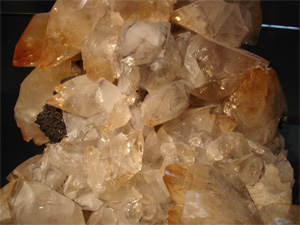
- Sample Number: 2
- Name: Gypsum
- Grain Size: Large crystals
- Color: Mostly transparent, hints of beige
- Lustre: Vitreous
- Optical Properties: Fiberous / Translucent
- Crystal Form: Monoclinic
- Location: Dwyer Mine
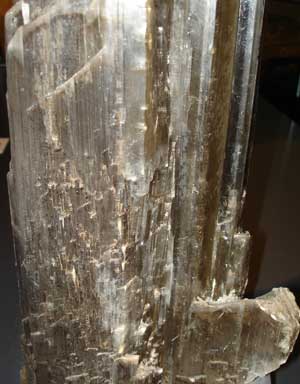
- Sample Number: 3
- Name: Quartz (Amethyst)
- Grain Size: Large Crystals
- Color: Purple and Transparent
- Lustre: Vitreous
- Optical Properties: Transparent / Stained Glass
- Crystal Form: Trigonal
- Location: Thunder Bay
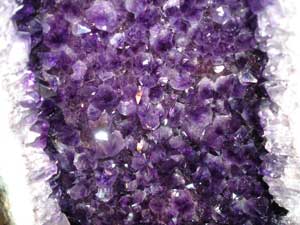
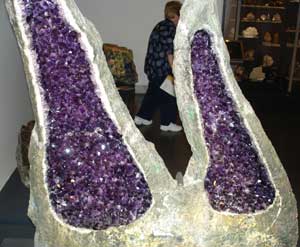
- Sample Number: 4
- Name: Chalcopyrite
- Grain Size: no visible grains
- Color: Gold
- Lustre: Metallic
- Optical Properties: Opaque, Shiny
- Crystal Form: disphenoid
- Location: Bessemer Mine
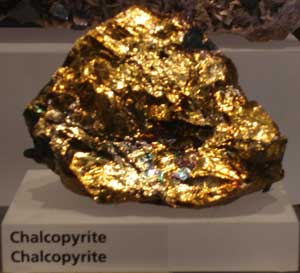
- Sample Number: 5
- Name: Galena
- Grain Size: Large 1 – 2” cubes
- Color: Dark Silver Grey
- Lustre: Dull Metallic
- Optical Properties: Opaque
- Crystal Form: Cubic
- Location: Davis Quarry
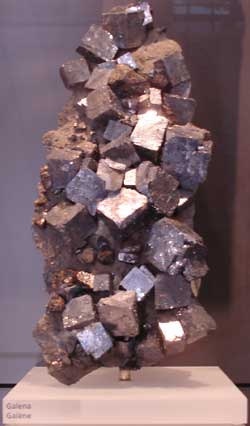
- Sample Number: 6
- Name: Muscovite
- Grain Size: Gravel size grains
- Color: White and Green
- Lustre: Vitreous
- Optical Properties: Mostly opaque, some transparency
- Crystal Form: Monoclinic
- Location: Goulding-Keene Quarry, Gutz Farm
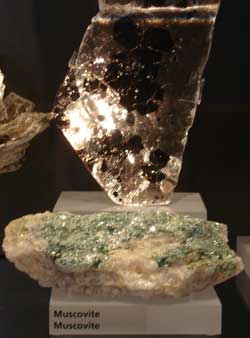
- Sample Number: 7
- Name: Microcline (Feldspar)
- Grain Size: 0.5 – 4” cubic shape
- Color: White, tinted with beige
- Lustre: Pearly
- Optical Properties: Opaque
- Crystal Form: Cubic
- Location: MacDonald Mine, Diamond Lake Roadcut, Musclow Occurrence
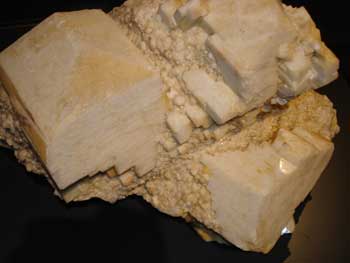
- Sample Number: 8
- Name: Titanite
- Grain Size: 1 – 3” crystals
- Color: Black with some brown edges
- Lustre: metallix, somewhat metallic, shiny
- Optical Properties: Opaque
- Crystal Form: Trigonal
- Location: Bear Lake Occurence, Bower’s Point Roadcut, Burgess Corundum, Desmont Mine, Diamond Lake Roadcut, Musclow Occurrence, North Baptiste Lake Occurence, Saranac Mine
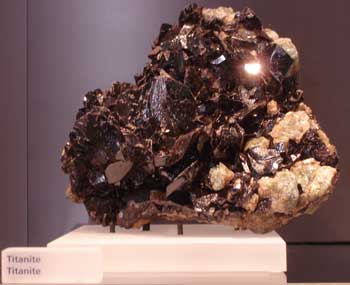
- Sample Number: 9
- Name: Pyrite
- Grain Size: 0.25 – 3” cubic
- Color: Gold
- Lustre: Metallic
- Optical Properties: Opaque, reflective
- Crystal Form: cubic
- Location: Baptiste Lake North Occurrences, Bessemer Mine, Burgess Corundum, Desmont Mine, Egan Chute, Faraday Hill Roadcut, Goulding-Keene Quarry, Grace Lake Roadcut, Warwickite Occurrence
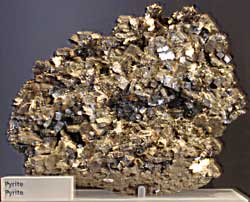
- Sample Number: 10
- Name: Graphite
- Grain Size: no distinguishable grains of crystals
- Color: silver / grey
- Lustre: Metallic
- Optical Properties: opaque, reflective
- Crystal Form: Hexagonal
- Location: Goulding-Keene Quarry, Saranac Mine
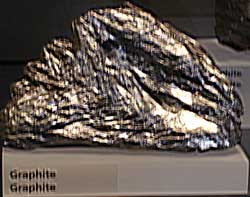
- Sample Number: 11
- Name: Hematite
- Grain Size: 1” diameter spherical bubbles
- Color: rainbow colored, like motor oil in water
- Lustre: Vitreous
- Optical Properties: Opaque
- Crystal Form: Oolitic
- Location: Quirk Lake, Musclow Occurrence
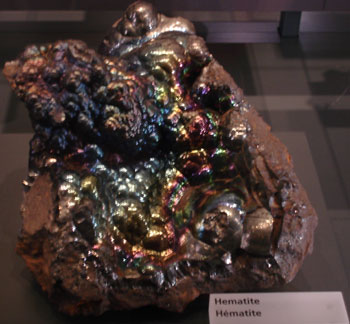
Discussion
Rocks’ Formation
The discussion of the research results should be started with the consideration of the processes that facilitated the formation of the eleven rocks whose samples have been observed during the visit to the museum. Thus, samples 1 and 2 are the pieces of gypsum that were formed by the mineral precipitation from saline waters in Dwyer Mine (Rocks, Minerals, and Mines of Ontario Canada in Ontario’s Algonquin Park and area, 2009). This way of formation facilitated the inclusions of the number of other minerals in this sample and determined its almost completely transparent color and the obvious bubbles of air in its structure (Eyles, 2002). Sample 3, amethyst originating from Thunder Bay, was formed by the interaction of iron elements and radiation that is produced by iron when the electricity or light goes through the crystal. The excessive iron atoms are aligned in amethyst crystals, and this makes them transparent and violet, especially in the sunlight (Eyles, 2002). Sample 4 presents the example of chalcopyrite from the Bessemer Mine, the element formed of copper in its major part. The sample of chalcopyrite was formed by the interaction of copper atoms in the mineral molecules at the low degree of yield which amounts to 25%. Galena, the fifth sample analyzed, is the source of lead mineral ore from Davis Quarry. The completion of the mineral’s formation takes place after its exposure to air when it turns from transparent to dull iron (Rocks, Minerals and Mines of Ontario Canada in Ontario’s Algonquin Park and area, 2009).
Sample 6 among the analyzed mineral pieces is the example of muscovite, the rock mineral type which is considered to be the so-called primary mineral. The sample under consideration was found in Goulding-Keene Quarry (Rocks, Minerals, and Mines of Ontario Canada in Ontario’s Algonquin Park and area, 2009). Muscovite can be observed in various forms and either yellow color or a colorless state. Microcline, also known as feldspar, is the seventh sample among the considered minerals. This mineral sample originates from MacDonald Mine. Usually, microcline is observed in the plutonic felsic rocks, but can also be observed in high-grade metamorphic veins, pegmatites, and hydrothermal veins. The mineral is characterized by the high degree of hardness, 6 – 6,5, and by the reduced cell parameters (Rocks, Minerals and Mines of Ontario Canada in Ontario’s Algonquin Park and area, 2009). The eighth sample under analysis is the piece of titanite found in the Bear Lake Occurrence and several other locations. This mineral is the composition of such elements as calcium, titanium, silicon, aluminum, iron, and fluorine. The ninth sample, pyrite, originates from Bessemer Mine. It is a primary mineral that can be observed in several geological structures including metamorphic rocks, veins, etc (Eyles, 2002). Graphite, the tenth sample under consideration, originates from Saranac Mine. It is formed in platelike particles with hexagonal or broken edges. Hematite, the eleventh sample originating from Quirk Lake and Musclow Occurrence is formed by sedimentary minerals, high-grade ores, and extrusive rocks (Eyles, 2002). On the whole, the samples under analysis present the minerals that are found most often at basins, mines, and sediments of Ontario. The development of the very places of origin of these samples also presents considerable interest for the study of the geology of Ontario.
Area Structure
The below presented geological map illustrates the distribution of the discussed, and other, minerals over the territory of Ontario. Displaying only the major units of the geological division of Ontario, the map allows seeing which minerals are in substantial supply in Ontario, and which ones can be found not so often, and what the major sources of those minerals are:
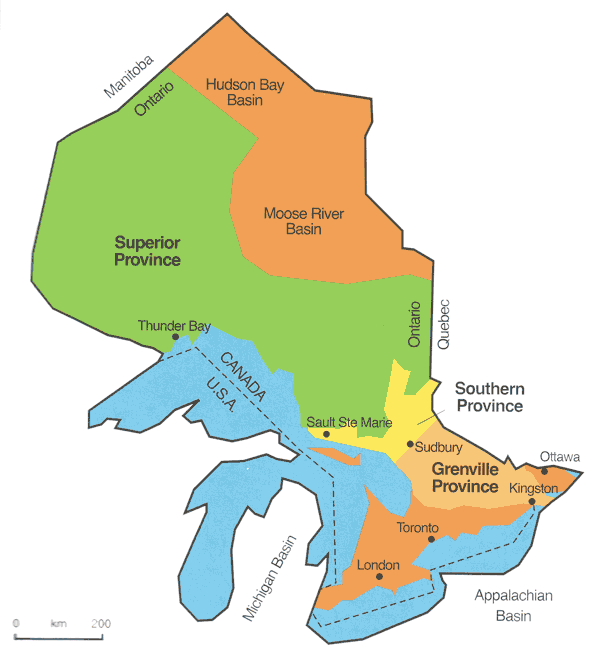
Thus, the southern part of the territory is characterized by rich gypsum deposits retrieved at the Dwyer Mine (Plummer & Carlson, 2007). The formation of the deposits is the result of the past coverage of the south of Ontario with water which provided for the favorable gypsum-forming conditions. The south of Ontario is also rich in chalcopyrite and galena. This fact allows arguing about the considerable copper ore and lead supplies concentrated in the south of Ontario (Plummer & Carlson, 2007). Copper ore, serving as the basic element of chalcopyrite, and the lead ore as the basis of galena, are the most widespread elements in the area. The northern areas are characterized by substantial amethyst supplies, observed especially in Thunder Bay (Rocks, Minerals and Mines of Ontario Canada in Ontario’s Algonquin Park and area, 2009). The conditions that provide for amethyst deposits are constructed by the excessive iron supplies and somewhat increased radiation levels observed in geological formations in the north of the territory of Ontario (Rocks, Minerals, and Mines of Ontario Canada in Ontario’s Algonquin Park and area, 2009).
The eastern and northern parts of Ontario are also characterized by considerable mineral deposits. In the east, Ontario is rich in muscovite, microcline, and titanite observed in Goulding-Keene Quarry, MacDonald Mine, and Bear Lake Occurrence respectively (Rocks, Minerals, and Mines of Ontario Canada in Ontario’s Algonquin Park and area, 2009). Being the sources of primary minerals, Goulding-Keene Quarry and MacDonald Mine develop as the geological formations in which muscovite and microcline can be formed, i. e. pegmatites, felsic rocks, high-grade metamorphic veins, and hydrothermal veins (Plummer & Carlson, 2007). Titanite as the sample demanding the whole variety of minerals for its composition develops in the east only where the natural supplies of calcium, titanium, silicon, aluminum, iron, and fluorine are enough for this process. The west of Ontario is the territory that offers considerable deposits of pyrite, graphite, and hematite, and it is the nature of these minerals that makes the deposits develop in the way they do(Rocks, Minerals, and Mines of Ontario Canada in Ontario’s Algonquin Park and area, 2009). Thus, Bear Lake Occurrence and several minor locations like Burgess Corundum, Desmont Mine, Egan Chute, Faraday Hill Roadcut develop as copper-containing deposits of minerals used in various industrial purposes (Eyles, 2002). Saranac Mine, as well as the Quirk Lake and Musclow Occurrence, are well-known graphite and hematite sources whose products are used not only for scientific but for economic and industrial purposes as well (Rocks, Minerals and Mines of Ontario Canada in Ontario’s Algonquin Park and area, 2009).
Moreover, Ontario is subdivided into three main geological provinces; they are Superior Province, Southern Province, and Grenville Province (Rocks, Minerals, and Mines of Ontario Canada in Ontario’s Algonquin Park and area, 2009). Superior Province is the oldest one in Ontario with an age of over 3 billion years. It covers almost the whole northern part of it. There are 12 smaller subprovinces in Superior Province, and they are divided by faults and geological formations. The four major minerals and rocks observed in Superior Province include granite-greenstone formations, sedimentary, plutonic, and high-grade formations created from volcanic and plutonic rocks and greenstone slices. Rock of this province was formed from ancient sea floors and volcanoes to form long belts of volcanic rocks in the modern superior (Eyles, 2002).
Southern Province dates back to 2.49 – 2.21 billion years, and consists of the rock sediments whose thickness amounts to the range between 3,000 to 15,000 meters. The rocks of the Southern Province were formed mainly by winds, rivers, and glaciers that affected the ancient ocean. The mountain-building period took place when Ontario collide3d with another continent part in pre-historic times. 1.11 billion years ago the Southern Province collided with the Sudbury meteorite that brought lots of minerals like granite, greenstone, etc. to the area and facilitated the formation of volcanic rocks in the province (Rocks, Minerals, and Mines of Ontario Canada in Ontario’s Algonquin Park and area, 2009).
The Grenville Province was formed as the result of Earth’s crusts collision that led to the formation of major mountain ranges from terranes in the time frame of 1.76 – 1 billion years ago. Between 1.8 and 1 billion years ago, the metamorphic rocks were formed by numerous stretches and twists of Grenville rocks. Grenville Province consists of two major belts; they are Central Genesis Belt and Central Metasedimentary Belt (Plummer & Carlson, 2007).
To conclude, Ontario is a mineral-rich province whose major rocks include such varieties as gypsum, amethyst, pyrite, graphite, hematite, and many others. These elements can be primary and complex, their distribution is carried out according to the geographical principle and the past historical conditions of the region. The use of the minerals in Ontario includes scientific, collecting, and industrial purposes.
Works Cited
Eyles, Nick. Ontario Rocks. Markham, ON: Fitzhenry & Whiteside, 2002.
Plummer, C. & Carlson, D. Physical Geology. McGraw-Hill Science/Engineering/Math; 12 edition, 2007.
“Rocks, Minerals and Mines of Ontario Canada in Ontario’s Algonquin Park and area.”2009.